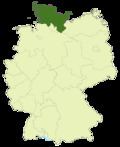Country Germany Current champions SV Eichede
(2015–16) Current champion SV Eichede Promotion to Regionalliga Nord | State Schleswig-Holstein Number of teams 18 Date founded 1947 | |
 | ||
Level on pyramid German football league system Relegation to Verbandsliga Schleswig-Holstein-Nord-West Teams VfB Lübeck, Heider SV, SV Eichede, VfR Neumünster, Flensburg 08 | ||
The Schleswig-Holstein-Liga, sometimes also referred to as Oberliga Schleswig-Holstein, is the fifth tier of the German football league system and the highest league in the German state of Schleswig-Holstein. It is one of fourteen Oberligas in German football.
Contents
1945–1963
The league was formed in 1947 as Schleswig-Holstein-Liga by thirty clubs in three divisions of ten, in the newly created state of Schleswig-Holstein which was then part of the British occupation zone in Germany. On 30 August 1947, the Schleswig-Holstein FA (SHFV) was formed.
From the start, the league was a feeder league to the Oberliga Nord which its champion had the option of promotion to. Promotion had to be archived through a play-off with teams from the Amateurligen of Niedersachsen, Bremen and Hamburg. As such, the league was now the second tier of the northern German league system. The league was renamed Landesliga Schleswig-Holstein (English:Schleswig-Holstein State League) in 1948 and united in one division of twelve teams, with the bottom two teams relegated to one of the four Bezirksklassen.
In 1951, the league was expanded to sixteen teams. The number of clubs in the league fluctuated to eighteen and seventeen in 1954-55 and 1955–56 and then returned to sixteen again.
From 1954, the league was renamed Amateurliga Schleswig-Holstein.
1963–1974
In 1963, with the introduction of the Bundesliga, the disbanding of the Oberliga Nord and the formation of the Regionalliga Nord, the league fell to tier three, but remained unchanged otherwise, with sixteen clubs as its strength. The champion of Schleswig-Holstein continued to have to play-off for promotion, now to the Regionalliga.
From 1968, the Amateurliga reverted to the name Landesliga Schleswig-Holstein. Below the Landesliga, the number of leagues was reduced from four to two, the new Verbandsligen of Schleswig-Holstein-Nord and -Süd.
1974-1994
After the 1973-74 season, the Regionalliga Nord was disbanded in favor of the 2nd Bundesliga Nord. The new Oberliga Nord was now introduced in northern Germany, as the third tier of the league system, below the 2nd Bundesliga. This meant for the Landesliga a slip to tier four. The top two team of the league was however promoted to the new Oberliga. The system for promotion from the Landesliga remained mostly unchanged.
In 1978, the league was finally renamed Verbandsliga Schleswig-Holstein, the name it carried until 2008. It took ten seasons for a club of the league under the new name to gain promotion again, a long stretch of nine seasons without success. Below the Verbandsliga the two leagues were now renamed Landesligen instead.
1994–2008
In 1994, the Regionalliga Nord was re-established, now as the third tier of the league system. The Oberliga Nord was in turn replaced by two parallel Oberligas, Niedersachsen/Bremen and Hamburg/Schleswig-Holstein. For the Verbandsliga Schleswig-Holstein, this meant a further slip, now to tier five, but also, for the first time in its history, direct promotion for the league champion and, in some seasons, even the runners-up. In 1994, the league saw its top eight clubs elevated to the new Oberliga.
From 1999, the number of leagues below the Verbandsliga was extended from two to four and the leagues renamed Bezirksoberliga.
The 1999-2000 season saw another league system change with the reduction of numbers of Regionalligen, this however had no effect on the Verbandsliga.
In 2004, it was decided to restore the Oberliga Nord in favor of the two separate Oberligen.
The league was expanded, for the first time, to eighteen teams, for the next three seasons. In 2007-08, the number increased to nineteen. The 2006-07 league winner, TSV Kropp, did not apply for an Oberliga licence and was not promoted. Fifth placed FC Kilia Kiel applied but was refused a licence.
2008 onwards
At the end of the 2007–08 season, the new 3. Liga was established and the Oberliga Nord disbanded, again. The four northern German states were then be the only region without an Oberliga and the five Verbandsligen sit right below the Regionalliga Nord, parallel to the two NOFV-Oberligas. At the end of the 2007-08 season, the five winners of the northern Verbandsligas played with the sixth placed team from the Oberliga Nord for one last spot in the Regionalliga. In the future seasons, promotion for the Schleswig-Holstein champion will only be available through a set of play-off matches with the league winners from Hamburg and Bremen. These three teams will compete for one promotion spot to the Regionalliga.
The Schleswig-Holstein-Liga however maintained its status as a tier five league. This fact means the league is now on the same level as other Oberligas in Germany. Accordingly, the league dropped the name Verbandsliga and simply calls itself Schleswig-Holstein-Liga. The leagues below it then adopted the name Verbandsliga. From the 2017-18 season onwards, the league will be known as the Oberliga Schleswig-Holstein and have relegation to the new Landesliga Schleswig-Holstein in the sixth tier.
Winners of the Schleswig-Holstein-Liga
The league champions:
Northern Group
Eastern Group
Western Group
League placings
The complete list of clubs and placings in the league since elevation to Oberliga status (2008–Present):
